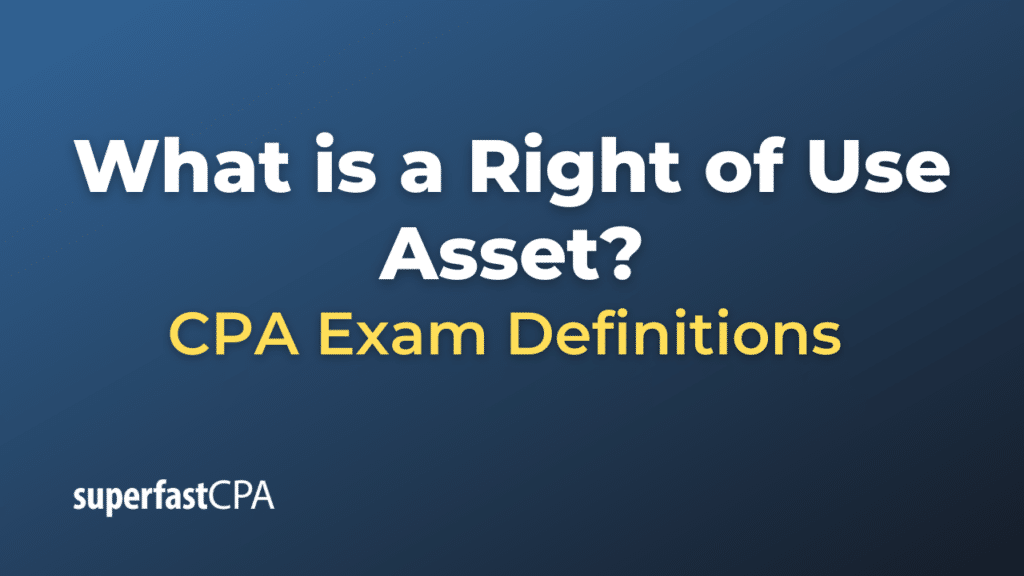Right of Use Asset
A “Right of Use (ROU) Asset” arises from the accounting for leases under the accounting standards established by the International Accounting Standards Board (IASB) and the Financial Accounting Standards Board (FASB). Specifically, this concept is detailed in the IFRS 16 standard (issued by the IASB) and ASC 842 (issued by the FASB).
The adoption of these standards changed how leases are recognized, measured, and disclosed in financial statements, especially for lessees. Before the adoption of these standards, many leases, especially operating leases, did not appear on the lessee’s balance sheet.
Here’s a breakdown of the concept:
1. Recognition: Under the new standards, lessees are required to recognize an asset for the right to use the leased item and a corresponding liability for the obligation to make lease payments. This recognition is for both finance and operating leases, with few exceptions.
2. Calculation: The ROU asset is initially measured at the amount of the lease liability, plus any initial direct costs incurred by the lessee, any lease payments made before the lease commencement date (minus any lease incentives received), and the estimated costs for dismantling and removing the underlying asset or restoring the site on which it’s located.
3. Amortization: Over the lease term, the ROU asset is typically amortized on a straight-line basis, and the lease liability is reduced by payments made, adjusted for interest.
4. Presentation: In the balance sheet, the ROU asset is generally presented within property, plant, and equipment, but separately from owned assets. The lease liability is presented separately from other liabilities.
Example of a Right of Use Asset
Suppose RetailCo, a retail company, enters into a 10-year lease for a prime storefront in a shopping mall. The annual lease payments are $200,000, payable at the end of each year. For simplicity, let’s use a discount rate of 5% to compute the present value of these lease payments.
Initial Recognition:
- Lease Liability : To determine the initial value of the lease liability, RetailCo would calculate the present value of the future lease payments using the 5% discount rate.
- PV = $200,000 / (1 + 5%) + $200,000 / (1 + 5%)^2 + … + $200,000 / (1 + 5%)^10
- This equals approximately $1,554,757.
- ROU Asset: Initially, the ROU asset would be equivalent to the lease liability as there are no initial direct costs, prepaid lease payments, or incentives to adjust for. So, the ROU asset would also be $1,554,757.
Subsequent Accounting:
At the end of Year 1:
- Lease Payment: RetailCo pays $200,000.
- Interest Expense: The interest on the lease liability for the year would be 5% * $1,554,757 = $77,738.
- Reduction in Lease Liability : The liability would reduce by the lease payment minus the interest expense:
- Reduction = $200,000 – $77,738 = $122,262
- New Lease Liability = $1,554,757 – $122,262 = $1,432,495
- Amortization of ROU Asset: The asset would typically be amortized on a straight-line basis over 10 years. For the first year:
- Amortization = $1,554,757 / 10 = $155,476
- New ROU Asset value = $1,554,757 – $155,476 = $1,399,281
- On the balance sheet at the end of Year 1:
- Lease Liability: $1,432,495
- ROU Asset: $1,399,281
- On the income statement for Year 1:
- Lease Interest Expense: $77,738
- Amortization Expense: $155,476
This example provides an overview of how RetailCo would recognize and subsequently account for the lease under the new leasing standards. In reality, lease contracts can be more complex, with various adjustments, options, and contingencies that might affect the accounting treatment. However, the fundamental principle is to recognize a company’s right to use an asset and the obligation to pay for that right on the balance sheet.













